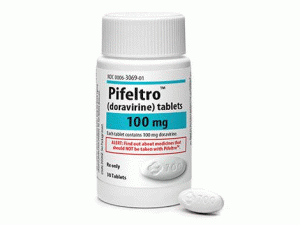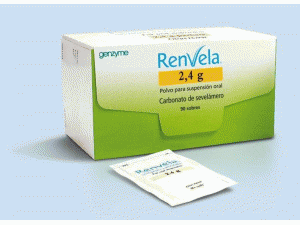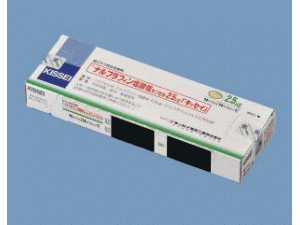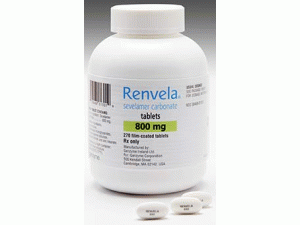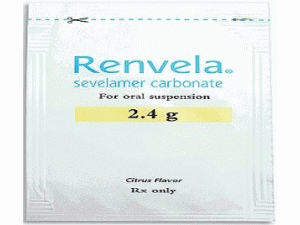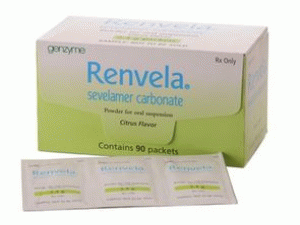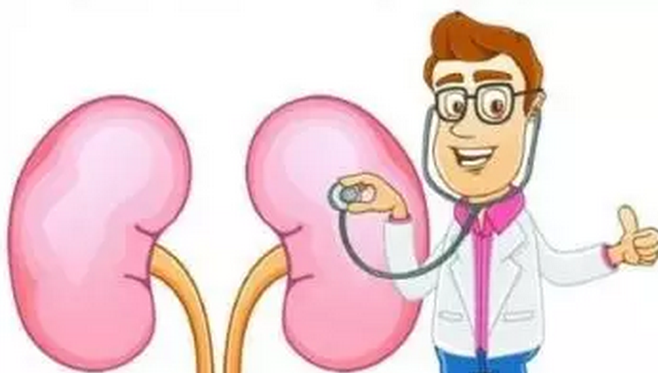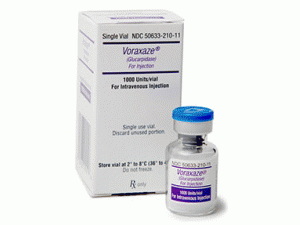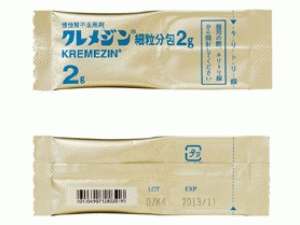酒石酸半胱胺缓释胶囊cysteamine bitartrate (Procysbi Capsules 75mg)
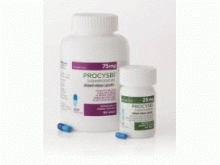 产地国家:美国
处 方 药:是
所属类别:75毫克/粒 250粒/瓶
包装规格:75毫克/粒 250粒/瓶
计价单位:瓶
生产厂家中文参考译名:Horizon Therapeutics USA, Inc.
生产厂家英文名:Horizon Therapeutics USA, Inc.
原产地英文商品名:Procysbi 75mg/Capsules 250Capsules/bottle
原产地英文药品名:cysteamine bitartrate delayed-release
中文参考商品译名:Procysbi缓释胶囊 75毫克/粒 250粒/瓶
中文参考药品译名:酒石酸半胱胺
产地国家:美国
处 方 药:是
所属类别:75毫克/粒 250粒/瓶
包装规格:75毫克/粒 250粒/瓶
计价单位:瓶
生产厂家中文参考译名:Horizon Therapeutics USA, Inc.
生产厂家英文名:Horizon Therapeutics USA, Inc.
原产地英文商品名:Procysbi 75mg/Capsules 250Capsules/bottle
原产地英文药品名:cysteamine bitartrate delayed-release
中文参考商品译名:Procysbi缓释胶囊 75毫克/粒 250粒/瓶
中文参考药品译名:酒石酸半胱胺
简介
近日,美国食品药品监督管理局(FDA)已批准首个胱氨酸症新药PROCYSBI(cysteamine bitartrate,酒石酸酒石酸半胱胺)缓释胶囊的适应症扩展至包括1岁及1岁以上的肾病性胱氨酸病患者。肾病性胱氨酸病(NC)是一种罕见的遗传病,它通过引起称为胱氨酸的蛋白质构件堆积而影响人体的每个细胞。胱氨酸的积累会在整个身体中引起肾脏和其他问题。NC可能导致9或10岁时身体发育缓慢和身材矮小,骨骼虚弱,甲状腺功能减退,失明,肌肉无力,肺功能障碍以及肾衰竭的发展和恶化,据估计,美国目前约有500人 全世界有2,000名被诊断为肾病性胱氨酸病。 批准日期:2013年4月3日 公司:Horizon Therapeutics USA, Inc. 最初的美国批准时间:1994年 作用机理:半胱胺是一种氨基硫醇,参与溶酶体中的硫醇-二硫键交换反应,将胱氨酸转化为半胱氨酸和半胱氨酸-半胱胺混合的二硫键,两者都可在胱氨酸病患者中退出溶酶体。 适应症和用途:PROCYSBI是一种胱氨酸消耗剂,可用于治疗成人和1岁及以上的小儿肾病性胱氨酸病。 用法用量 半胱胺初治患者的推荐剂量 有关基于剂量的剂量表的起始剂量和维持剂量,请参见完整的处方信息。 对于最初的耐受性,暂时中断治疗,然后以较低剂量重新启动PROCYSBI,然后逐渐增加至维持剂量。 从速释半胱胺切换到PROCYSBI 开始时,PROCYSBI的日总剂量等于速释半酒石酸酒石酸氢盐以前的日总剂量。 剂量滴定 调整剂量以达到治疗目标白细胞(WBC)胱氨酸浓度。 如果需要调整剂量,请将剂量增加10%。最大剂量为每天1.95克/平方米。 如果发生不良反应,请减少剂量。一些患者可能无法达到治疗目标。 胶囊:整粒吞服;不要压碎或咀嚼胶囊或胶囊内容物。将胶囊与果汁(西柚汁除外)或水一起服用。 口服颗粒:请勿压碎或咀嚼颗粒。将这些颗粒撒在苹果酱,浆果果冻或果汁(葡萄柚汁除外)中并混合。 对于无法吞服胶囊或使用胃造口管的患者,请参阅有关如何制备和服用胶囊和口服颗粒的完整处方信息。 含碳酸氢盐或碳酸盐的药物治疗前至少1小时或之后1小时服用PROCYSBI。 服用PROCYSBI之前和之后至少30分钟不要进食。如果不能不进食而不能服用PROCYSBI,请随食物一起服用,但在服药前1小时至服药后1小时将食物量限制在约4盎司(1/2杯)。避免高脂食物接近剂量。 服用PROCYSBI时避免饮酒。 剂量形式和强度 延迟释放胶囊:25mg和75mg半胱胺。 延迟释放口服颗粒剂:一次性包装中的75mg和300mg半胱胺。 禁忌症 对青霉素胺或半胱胺过敏。 警告和注意事项 Ehlers-Danlos样综合症:如果发生皮肤和骨骼损伤,请减少剂量。 皮疹:如果发生严重的皮疹,例如多形红斑大疱或中毒性表皮坏死,则不连续。 胃肠道(GI)溃疡和出血:监测胃肠道症状,并在出现严重症状时考虑减少剂量。 中枢神经系统(CNS)症状:监测CNS症状;中断或降低严重症状或持续或进展的症状的剂量。 白细胞减少症和/或碱性磷酸酶水平升高:监测白细胞计数和碱性磷酸酶水平;降低或中止剂量,直至值恢复正常。 良性颅内高压:监测体征和症状;中断或减少持续存在的体征/症状的剂量,如果确诊则不连续。 不良反应 最常见的不良反应包括: 先前接受半胱胺(≥5%)治疗的6岁及以上的患者有:呕吐,恶心,腹痛,呼吸异味,腹泻,皮肤异味,疲劳,皮疹和头痛。 单纯接受半胱胺治疗1年至6年以下的患者(> 10%)为:呕吐,胃肠炎/病毒性胃肠炎,腹泻,呼吸异味,恶心,电解质失衡和头痛。 在特定人群中的使用 哺乳期:不建议母乳喂养。 包装供应/存储和处理方式 供应方式 PROCYSBI(酒石酸半胱胺)缓释胶囊 25mg半胱胺:硬明胶胶囊,带有淡蓝色不透明盖,上面印有白色墨水中的“ PRO”,淡蓝色不透明体,上面印有白色墨水中的“ 25mg”,每瓶60胶囊(NDC 75987-100-04) 。每个瓶子包含一个干燥剂罐和一个氧气吸收罐。 75mg半胱胺:硬明胶胶囊,带有深蓝色不透明盖,上面印有白色墨水中的“ PRO”,浅蓝色不透明本体,上面印有白色墨水中的“ 75mg”,每瓶250胶囊(NDC 75987-101-08) 。每个瓶子包含一个干燥剂罐和两个氧气吸收罐。 PROCYSBI(酒石酸半胱胺)缓释口服颗粒 75mg半胱胺:包含白色至灰白色颗粒的一次性包装,每盒60包,每箱提供(NDC 75987-140-13)。 75mg半胱胺:包含白色至灰白色颗粒的一次性包装,以120包的纸箱形式提供(NDC 75987-140-14)。 300mg半胱胺:包含白色至灰白色颗粒的一次性包装,每盒60包,每箱提供(NDC 75987-145-13)。 300mg半胱胺:包含白色至灰白色颗粒的一次性包装,以120包的纸箱形式提供(NDC 75987-145-14)。 储存和处理 分配之前,将PROCYSBI缓释胶囊和PROCYSBI缓释口服颗粒保存在2°C至8°C(36°F至46°F)的冰箱中。 分配PROCYSBI缓释胶囊和PROCYSBI缓释口服颗粒剂,弃药日期为4个月。 用原包装分配。请勿细分或重新包装。 请勿从PROCYSBI延迟释放胶囊瓶中取出干燥剂或氧气吸收剂。将瓶子密封在干燥的地方。避光和防潮。 病人须知 将PROCYSBI缓释胶囊和PROCYSBI缓释口服颗粒在室温,20°C至25°C(68°F至77°F)的原始包装中存储。请勿细分或重新包装。避光和防潮。 不要将PROCYSBI延迟释放口服颗粒保存在打开的包装袋中。英文版说明书
FDA Approval to Expand the Indication for PROCYSBI(cysteamine bitartrate) Delayed-Release Capsules to Include Children One Year of Age and Older Living with Nephropathic Cystinosis U.S. Food and Drug Administration(FDA)has approved an expansion to the indication for PROCYSBI(cysteamine bitartrate) delayed-release capsules to include children one year of age and older living with nephropathic cystinosis. About Cystinosis Nephropathic cystinosis is a rare, life-threatening metabolic lysosomal storage disorder that causes toxic accumulation of cystine in all cells, tissues, and organs in the body. If untreated, elevated cystine accumulation leads to progressive, irreversible tissue damage and multi-organ failure, including kidney failure, blindness, muscle wasting and premature death. It is estimated that only about 2,000 people worldwide are currently diagnosed with nephropathic cystinosis.Nephropathic or “classic infantile” cystinosis – the most common and most severe form of the disease-is typically diagnosed in infancy and requires lifelong cystine depleting therapy. IMPORTANT SAFETY INFORMATION INDICATIONS AND USAGE:PROCYSBI(cysteamine bitartrate)delayed-release capsules is a cystine-depleting agent indicated for the treatment of nephropathic cystinosis in adults and pediatric patients 1year of age and older. CONTRAINDICATIONS: Hypersensitivity to penicillamine or cysteamine. WARNINGS AND PRECAUTIONS: Ehlers-Danlos-like Syndrome:Skin and bone lesions that resemble clinical findings for Ehlers-Danlos-like syndrome have been reported in patients treated with high doses of immediate-release cysteamine bitartrate or other cysteamine salts. These include molluscoid pseudotumors(purplish hemorrhagic lesions), skin striae, bone lesions(including osteopenia, compression fractures, scoliosis and genu valgum), leg pain and joint hyperextension. One patient on immediate-release cysteamine bitartrate with serious skin lesions subsequently died of acute cerebral ischemia with marked vasculopathy. Patients should be monitored for development of skin or bone lesions and PROCYSBI dosing should be interrupted if patients develop these lesions. PROCYSBI may be restarted at a lower dose under close supervision, then slowly increased to the appropriate therapeutic dose. Skin Rash:Severe skin rashes such as erythema multiforme bullosa or toxic epidermal necrolysis have been reported in patients receiving immediate-release cysteamine bitartrate.If severe skin rashes develop, use of PROCYSBI should be permanently discontinued. Gastrointestinal Ulcers and Bleeding: Gastrointestinal(GI)ulceration and bleeding have been reported in patients receiving immediate-release cysteamine bitartrate. GI tract symptoms including nausea, vomiting, anorexia and abdominal pain, sometimes severe, have been associated with cysteamine.If severe GI tract symptoms develop, decreasing the dose of PROCYSBI should be considered. Central Nervous System Symptoms:Central Nervous System(CNS)symptoms such as seizures, lethargy, somnolence, depression, and encephalopathy have been associated with immediate-release cysteamine. Neurological complications have also been described in some patients with cystinosis who have not been treated with cysteamine. Patients who develop CNS symptoms should be carefully eva luated and monitored. Medication should be interrupted or the dose should be adjusted as necessary for patients with severe symptoms or with symptoms that persist or progress. PROCYSBI may impair the ability of patients to perform tasks such as driving or operating machinery. Leukopenia and/or Elevated Alkaline Phosphatase Levels: Cysteamine has been associated with reversible leukopenia and elevated alkaline phosphatase levels. White blood cell counts and alkaline phosphatase levels should be monitored. If test values remain elevated, consider decreasing the dose or discontinuing the drug until values revert to normal. Benign Intracranial Hypertension: Benign intracranial hypertension(pseudotumor cerebri; PTC)and/or papilledema has been reported in patients receiving immediate- release cysteamine bitartrate treatment. Patients should be monitored for signs and symptoms of PTC, including headache, tinnitus, dizziness, nausea, diplopia, blurry vision, loss of vision, pain behind the eye or pain with eye movement.If signs/symptoms persist, dosing should be interrupted or the dose should be decreased and the patient should be referred to an ophthalmologist.If the diagnosis is confirmed, use of PROCYSBI should be permanently discontinued. ADVERSE REACTIONS: The most common adverse reactions(>10%)in patients treated in clinical trials reflected in the FDA approved product labeling were vomiting, gastroenteritis/viral gastroenteritis, diarrhea, breath odor, nausea, electrolyte imbalance and headache.用药温馨提示:当您服用此药物时,需定期接受医疗专业人士的检查,以便随时针对其药效、副作用等情况进行监测。本网站所包含的信息旨在为患者提供帮助,不能代替医学建议和治疗。
药品价格查询,专业药品查询网站,药品说明书查询,药品比价 » 酒石酸半胱胺缓释胶囊cysteamine bitartrate (Procysbi Capsules 75mg)
药品价格查询,专业药品查询网站,药品说明书查询,药品比价 » 酒石酸半胱胺缓释胶囊cysteamine bitartrate (Procysbi Capsules 75mg)

